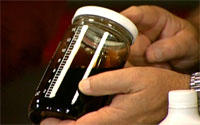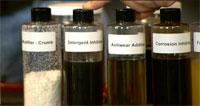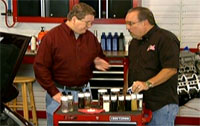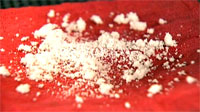Oil Additives
PAT GOSS: Over the years there’ve been huge differences in the way automobiles are made and there are also huge differences in the lubricants we need to use to protect them. Joining us once more is Thom Smith, who is a lubricants chemist. Welcome back to the show, Thom.
THOM SMITH: It’s good to be back Pat.
 GOSS: All right, let’s take a look at some of your displays here. One thing has remained constant and you have a sample here in this jar.
GOSS: All right, let’s take a look at some of your displays here. One thing has remained constant and you have a sample here in this jar.
SMITH: Yes that’s crude oil, and that’s still what we start with, and we use that to make the base fluid that we build the oil from.
GOSS: Okay now, base fluids.
SMITH: Right here we’ve got some base fluids, these are an older type through an extraction process, and we’re really limited with it to what molecules are in the crude oil. Here we have more modern base oils where they’re more highly refined and we actually can convert the molecules in the crude oil to really make an ideal, much higher quality base oil.
GOSS: All right, but this wouldn’t work in an engine.
SMITH: No, base oil alone isn’t enough, you need additives.
 GOSS: So here we have an assortment of additives, what’s this first one?
GOSS: So here we have an assortment of additives, what’s this first one?
SMITH: This one here is a detergent inhibitor and it’s a mix of detergents, dispersants, and anti-oxidants. The detergents keep the contaminants and combustion by-products from depositing on the engine. Dispersants keep them suspended in the oil, and the anti-oxidants protect the oil itself from chemical breakdown from the high heat.
GOSS: Okay the next one?
SMITH: The next one is a very important one, that’s something called Zinc-di-alkial-di-thio-phosphate. You may have heard it referred to as simply Zinc or Z-D-P or simply phosphorous, and that’s the primary anti-wear additive that goes into the oil. Back in that day it was in there probably at about three-hundred parts per million, today we’re looking at about eight-hundred parts per million.
GOSS: All right, the next one?
 SMITH: We have a corrosion inhibitor, one of the big things in combustion. You produce a lot of water, you’ve got a lot of iron in the engine, water and iron mean rust so you need something to fight that.
SMITH: We have a corrosion inhibitor, one of the big things in combustion. You produce a lot of water, you’ve got a lot of iron in the engine, water and iron mean rust so you need something to fight that.
GOSS: All right, now the milky one?
SMITH: That’s a friction modifier and that’s really important today. That reduces the internal friction of the engine so you reduce your fuel consumption, and with the price of fuel today, that’s really important.
GOSS: Now I’m guessing, although this looks like water, it isn’t.
 SMITH: No, if you hold that up, that’s really thick and what it is, is basically rubber dissolved in oil, and here’s a sample of the rubber. It’s a ground up rubber, and that really made a significant change in the types of oils we use. You put this into motor oil and it converts a single grade oil into a multi-grade oil, and the way it does it, these molecules are very large and when they get cold they shrink down into a tight little ball so that they don’t impede that flow of the oil, but when the oil heats up, these balls expand and swell and there’s arms reaching out from it and so that increases the viscosity of the oil, this allows you to be very light and flow easily at low temperatures but give high temperature protection by having a more viscous oil at high temperatures. This is how we make 5-20s, 5-30s, etcetera.
SMITH: No, if you hold that up, that’s really thick and what it is, is basically rubber dissolved in oil, and here’s a sample of the rubber. It’s a ground up rubber, and that really made a significant change in the types of oils we use. You put this into motor oil and it converts a single grade oil into a multi-grade oil, and the way it does it, these molecules are very large and when they get cold they shrink down into a tight little ball so that they don’t impede that flow of the oil, but when the oil heats up, these balls expand and swell and there’s arms reaching out from it and so that increases the viscosity of the oil, this allows you to be very light and flow easily at low temperatures but give high temperature protection by having a more viscous oil at high temperatures. This is how we make 5-20s, 5-30s, etcetera.
GOSS: This is what we referring to when we talk about a viscosity improver?
SMITH: Yes.
GOSS: Okay and the final result…
SMITH: You put all these together and you get a finished motor oil.
GOSS: Thom, thank you very much, really appreciate it.
If you have a question or comment, write to me.
The address is MotorWeek, Owings Mills, MD, 21117.





